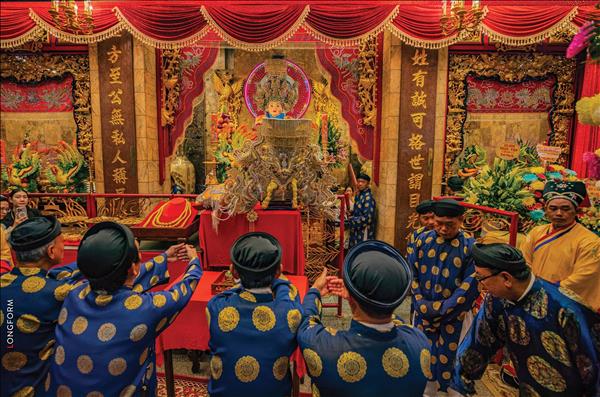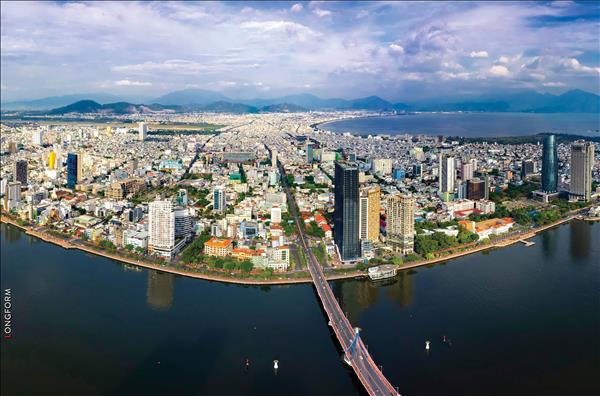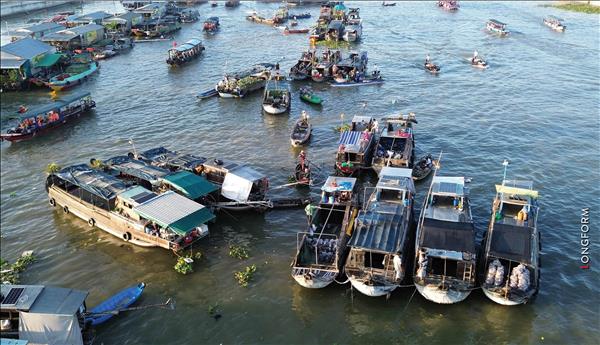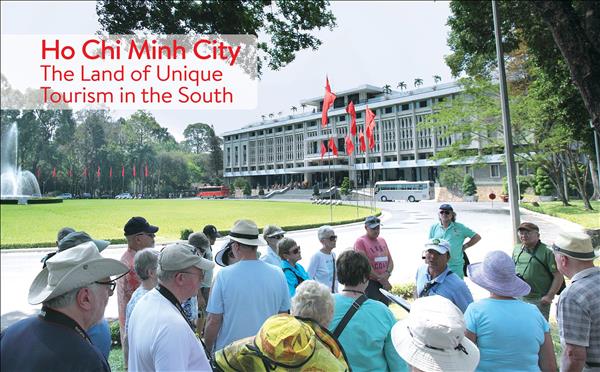Attractive destination
Located on the lower part of the Mekong delta with rich alluvial soil, interlacing canal networks, and temperate climate, the region has the best conditions for growing fruit trees. It is the country’s largest fruit growing area with fruits such as rambutan, mango, durian, longan, guava, orange and plum.
Many orchards in the Mekong delta are known nationwide, including Cai Be, Vinh Kim and Cho Gao in Tien Giang province; Cai Mon in Ben Tre; Cu Lao An Binh in Vinh Long; and My Khanh in Can Tho.
These orchards have not only brought in agricultural income, but have become attractive destinations for visitors to the Mekong delta.
Apart from beautiful orchards, the Mekong delta lures visitors to an original water lifestyle where people live and trade on boats, forming large floating markets like Cai Be in Tien Giang, Cai Rang in Can Tho, Nga Nam in Soc Trang, and Phung Hiep in Hau Giang.
Above all, the Mekong people’s fervor, hospitality and generosity make the region a truly worthwhile place to visit.
The provinces in the delta have taken all these advantages to develop original tours to Tien Giang, Ben Tre, Can Tho and Long An where visitors can see beautiful fruit-laden orchards and explore the life of southwestern farmers.
Amazing experience
From Ho Chi Minh City, we went to My Tho by bus and from there we took a boat tour to explore Thoi Son, one of the four popular islands in Tien Giang province.
From our beautifully decorated boat traveling the Tien River, we could see Thoi Son island appearing behind the greenery of immense orchards.
On this tour, we visited orchards where we ate rambutans, bananas and sapodillas fresh from the gardens and drank honey tea. We also went to craft villages in the area and learned the process of making coconut candy, girdle cakes and chocolate - the region’s known specialties.
The tour also offered us a chance to join fun activities such as rowing a three-plank boat, bailing out water to catch fish in a pond, walking on a monkey bridge, which is a very popular type of bridge in the Mekong delta. It is a simple, handmade bamboo or wooden bridge over a stream or channel.
On the tour, we also enjoyed a performance of dan ca tai tu (music of amateurs), a genre of chamber music typical of the traditional music of southern Vietnam.
The next day, we went to Tan Phong island in Cai Be district, which is home to verdant rambutan orchards and luxury resorts.
Entering Mekong Ecolodge, a nature-inspired resort in Cai Lay, we met Ronal Van Den Berg from the Netherlands and his family, and joined them on a bike tour to see Tan Phong island.
After a day tour exploring floating markets on the Cai Be River and observing the daily lives of the local people, we returned to Mekong Ecolodge for dinner where Ronal and his family made banh xeo (crispy pancake) with the help of the Mekong Ecolodge staff. The Dutch guests were happy to make and enjoy their own delicious pancakes, a typical dish of the southwestern region.
Ronal said that his family had visited different parts of Vietnam but was particularly impressed with the landscape and people in the Mekong delta. His children were happy to stay at Ecolodge’s comfortable bungalow in the middle of a reddish rambutan orchard. Getting up in the morning, they could pick and enjoy the fresh fruit and bike around the local area.
Ronal said his family would come back to Vietnam and explore other places in the Mekong delta.
Story: Son Nghia - Photos: Dang Kim Phuong & Nguyen Luan
Many orchards in the Mekong delta are known nationwide, including Cai Be, Vinh Kim and Cho Gao in Tien Giang province; Cai Mon in Ben Tre; Cu Lao An Binh in Vinh Long; and My Khanh in Can Tho.
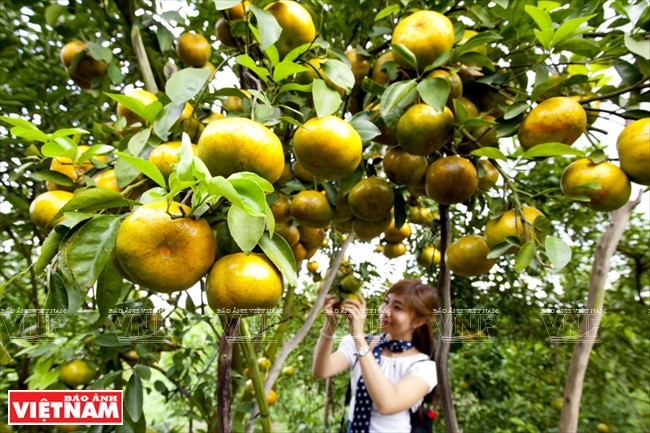 A mandarin orange orchard in Lai Vung, Dong Thap. Photo: Dang Kim Phuong 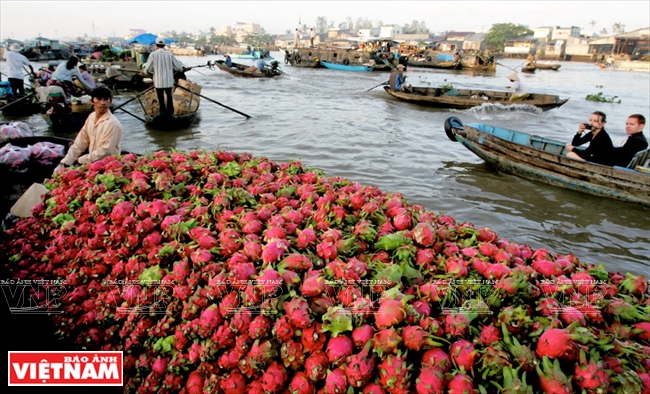 Cai Rang floating market in Can Tho, a big fruit market in the Mekong delta region. Photo: Trong Chinh At a pineapple orchard in Tien Giang. Photo: Nguyen Luan  Melons grown with VietGAP standards in Ben Tre. Photo: Dang Kim Phuong 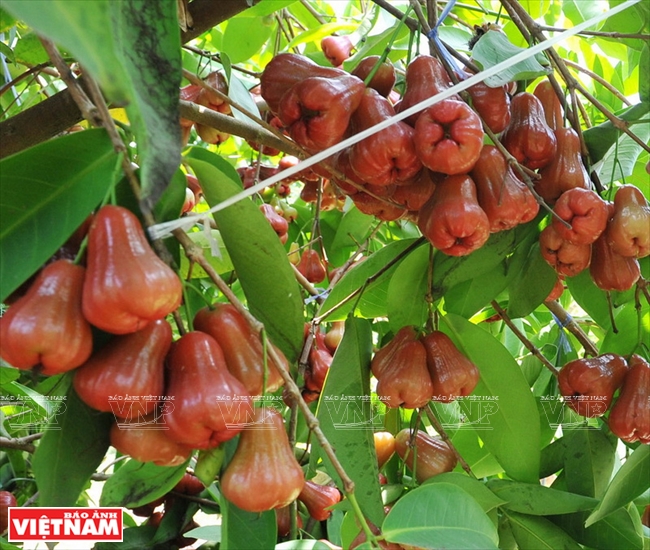 Rose apple grown in Can Tho. Photo: Dang Kim Phuong 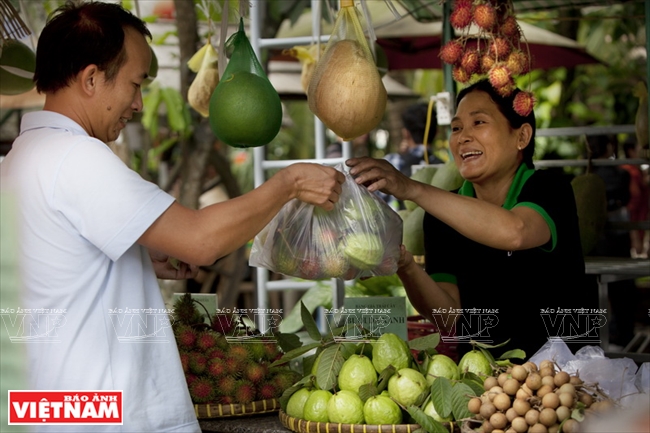 Fruit is a specialty of the Mekong delta. Photo: Dang Kim Phuong |
These orchards have not only brought in agricultural income, but have become attractive destinations for visitors to the Mekong delta.
|
The Mekong delta has a total orchard area of around 300,000 hectares, making up 37.5% of the country’s total. Its fruit output reaches about 3.8 million tons/year, accounting for over 70% of the total output nationwide. The region’s large fruit growers include Tien Giang with over 80,000 hectares; Ben Tre, 27,000 hectares; Dong Thap, 25,000 hectares, and Can Tho, 17,000 hectares. Source: The Southern Fruit Research Institute |
Above all, the Mekong people’s fervor, hospitality and generosity make the region a truly worthwhile place to visit.
The provinces in the delta have taken all these advantages to develop original tours to Tien Giang, Ben Tre, Can Tho and Long An where visitors can see beautiful fruit-laden orchards and explore the life of southwestern farmers.
Amazing experience
From Ho Chi Minh City, we went to My Tho by bus and from there we took a boat tour to explore Thoi Son, one of the four popular islands in Tien Giang province.
From our beautifully decorated boat traveling the Tien River, we could see Thoi Son island appearing behind the greenery of immense orchards.
On this tour, we visited orchards where we ate rambutans, bananas and sapodillas fresh from the gardens and drank honey tea. We also went to craft villages in the area and learned the process of making coconut candy, girdle cakes and chocolate - the region’s known specialties.
|
Foreign visitors on a green tour in Tien Giang. Photo: Dang Kim Phuong 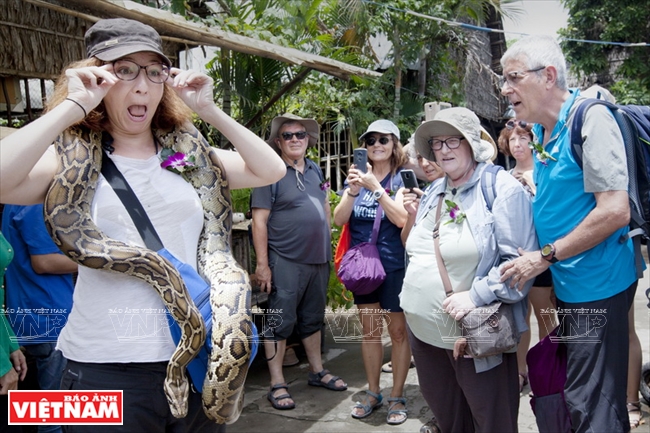 Playing with a python, a scary but exciting experience on a Mekong delta tour: Photo: Dang Kim Phuong 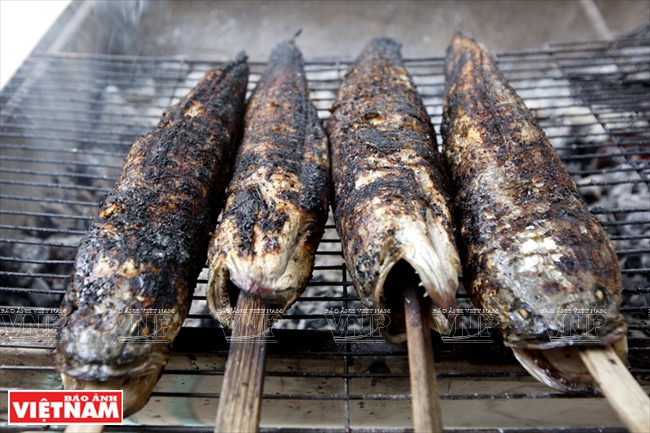 Grilled snake-head fish, a delicacy of the Mekong delta. Photo: Dang Kim Phuong Longan honey, a specialty of Tien Giang. Photo: Dang Kim Phuong  Visitors to Ben Tre can enjoy and learn how steamed rice pancakes are made. Photo: Dang Kim Phuong |
The tour also offered us a chance to join fun activities such as rowing a three-plank boat, bailing out water to catch fish in a pond, walking on a monkey bridge, which is a very popular type of bridge in the Mekong delta. It is a simple, handmade bamboo or wooden bridge over a stream or channel.
|
With three tourist attractions - Thoi Son island, Cai Be township and Tan Thanh beach, Tien Giang is attracting more tourists. The province hosts an average of over 1.5 million visitors a year. In 2017 alone, it attracted 1.8 million tourists, including 735,000 foreigners. Nguyen Tan Phong, Deputy Director, Department of Culture, Sports and Tourism of Tien Giang province |
The next day, we went to Tan Phong island in Cai Be district, which is home to verdant rambutan orchards and luxury resorts.
Entering Mekong Ecolodge, a nature-inspired resort in Cai Lay, we met Ronal Van Den Berg from the Netherlands and his family, and joined them on a bike tour to see Tan Phong island.
After a day tour exploring floating markets on the Cai Be River and observing the daily lives of the local people, we returned to Mekong Ecolodge for dinner where Ronal and his family made banh xeo (crispy pancake) with the help of the Mekong Ecolodge staff. The Dutch guests were happy to make and enjoy their own delicious pancakes, a typical dish of the southwestern region.
|
A corner of Lan Vuong tourist complex in Ben Tre. Photo: Nguyen Luan 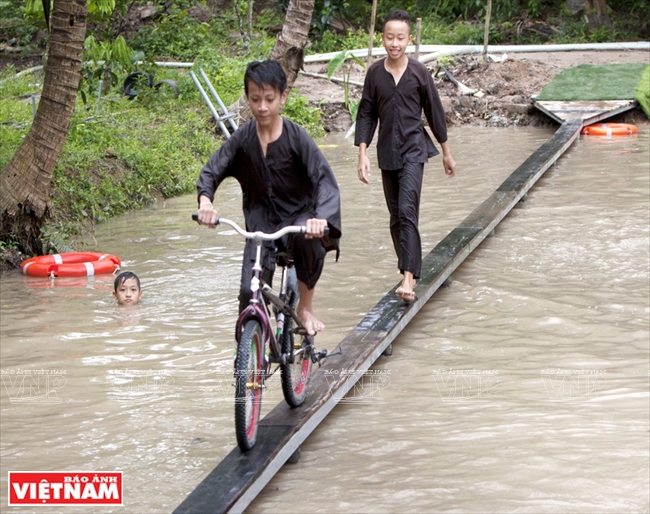 Students on a summer vacation in Ben Tre. Photo: Dang Kim Phuong Crossing the river using a pulley system is an amazing experience. Photo: Nguyen Luan Foreigners learn how to make Vietnamese fried spring rolls as part of a Ben Tre orchard tour. Photo: Dang Kim Phuong Enjoying Don ca tai tu (music of amateurs), a beautiful cultural trait of people in the southwestern region. Photo: Nguyen Luan 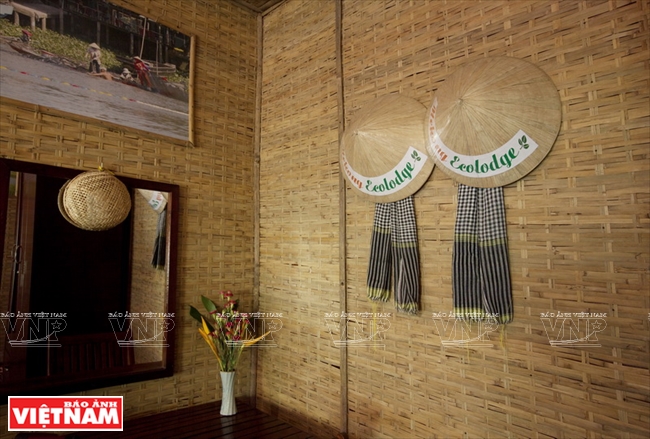 At a resort in Tieng Giang. Photo: Dang Kim Phuong 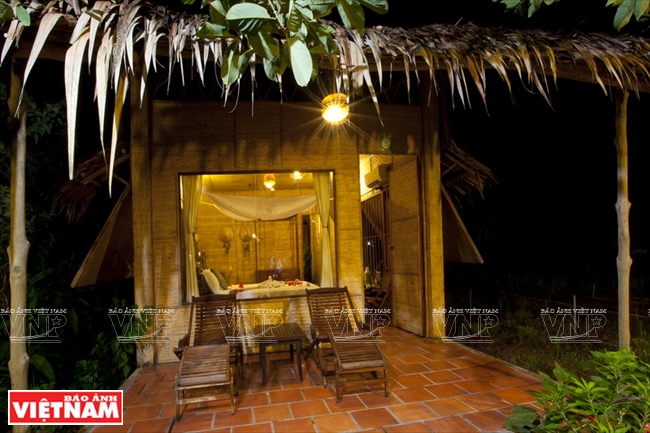 Nature-inspired Mekong Ecolodge Resort is a favorite place for visitors. Photo: Nguyen Luan The swimming pool at Nam Hien Garden House in Cho Lach, Ben Tre. Photo: Nguyen Luan |
Ronal said that his family had visited different parts of Vietnam but was particularly impressed with the landscape and people in the Mekong delta. His children were happy to stay at Ecolodge’s comfortable bungalow in the middle of a reddish rambutan orchard. Getting up in the morning, they could pick and enjoy the fresh fruit and bike around the local area.
Ronal said his family would come back to Vietnam and explore other places in the Mekong delta.
| At a conference on promoting investment in Tien Giang province in August, which was attended by Prime Minister Nguyen Xuan Phuc, the province called for investment in hi-tech agriculture, trade and services, processing and satellite industries, and particularly tourism, prioritizing the development of luxury hotels, tourist spots and highspeed boat and yacht services. |
Story: Son Nghia - Photos: Dang Kim Phuong & Nguyen Luan

